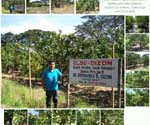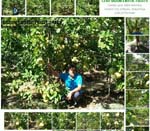|
Varietal Selections |
|
|
 |
 |
|
|
The Philippine Star,
Agriculture/Environment, Sunday, March 30, 2003 |
|
Davao high value fruit trees
winning ventures in Luzon
|
|
by Ramon Ma.
Epino |
| |
|
High value fruit trees that are a pride of Davao in
Mindanao can now be grown into winning ventures in
Luzon and elsewhere. This has been demonstrated by
successful orchard growers - of Davao Magallanes
pomelo, durian, longkong lanzones and mangosteen -
in Batangas, Quezon, Laguna, and Nueva Ecija.
In the heart of Quezon City at the Department of
Environment and Natural Resources - Protected Areas
and Wildlife Bureau-Dizon botanic fruit garden at
the Ninoy Aquino Parks and Wildlife, a techno-demo
farm managed by pomologist Bernie Dizon, these
money-making high value fruit trees are now a-bloom
and fruiting. For interested hobbyist, entrepreneurs
and orchard growers, he is conduction
lecture-seminars on these money-makers and other
exotic fruit trees for free on Sundays.
At Central Luzon State University (CLSU), a
one-hectare demo-farm run by Dizon through a
memorandum of agreement is lush and fruiting well
since 1999 with durian, mangosteen, Davao pomelo,
rambutan, lanzones, lychees, chokonan, |
 |
|
Guimaras and golden queen
mangoes from Taiwan and other exotic fruit trees.
|
| The
durian and longkong lanzones that survived at the CLSU are
now fruiting at Lingap Kalikasan under the supervision of
Dr. Jose Tabago. As provided for in the MOA, Dizon's land
rental will be the fruit trees that he nurtured at the CLSU.
|
| |
|
 |
| Dr. Fortunato
A. Battad pose with the only Durian that
survived out of hundred of double and triple
rootstock given to the University as land
rental of Bernardo O. Dizon at Lingap
Kalikasan, Central Luzon State University |
|
In Tiaong, Quezon, the CLSU-Dizon Orchard
Techno-Demo Farm owned by Atty. Victor P. Lazatin,
durian, longkong lanzones, rambutan, mangosteen and
lychee are now in full bloom. Not too far away in
Calauan, Laguna, Luie Gibe is now enjoying the fruit
of his labor in his farm. Magallanes pomelo, durian,
lychee and rambutan are now commercially fruiting
and bringing in tremendous profits.
Dizon says rice farmers can take advantage of extra
incomes offered by these high value fruit trees.
These can be grown at the fringes of the rice fields
and the dikes (pilapil) that subdivide the vast
tracks of the rice fields.
With the right technology (among them, topworking)
and superior varieties fruit trees can be
successfully farmed anywhere in the Philippines. |
|
| |
The following superior
varieties are recommended:
* Durian: Monthong from Thailand and D24 from Malaysia;
* Lanzones: Longkong which is currently priced at P350 per
kilo in Metro Manila as compared with P70 per kilo of the
local Paete variety;
* Pomelo: Magallanes or Nenita;
* Mangosteen: Lucban variety or Davao variety;
* Lychee: grafted tropical variety;
* Longan: grafted tropical variety.
Dizon provides tips on how to plant these high value fruit
trees
1. Plant double rootstock to strengthen growth and fruiting
efficiency. Double rootstocked trees can withstand strong
wind and adverse weather condition.
2. Plant Magallanes pomelo, mango, lychee, longan, local and
imported mangoes in areas with full sunlight.
3. Provide 50 percent shade on durian, lanzones, rambutan
during early years. Plant banana in-between the fruit trees
to serve as temporary shades.
4. Mangosteen should be planted on farm with 70 percent or
more shade. Plant grafted mangosteen to utilize shaded area.
5. Always make planting base porous and fertile. Clay soil
should be mixed with one-third rice hull or sand to make it
porous. Mix also with decayed manure.
6. Make a mound one meter high on rice field with a diameter
of one and one-half meters. The roots must not be submerged
or subjected to waterlogging to avoid root rot. |
|
|
|
|
|
 |
|
CLSU-DIZON |
|
PROJECT |
 |
|
|

